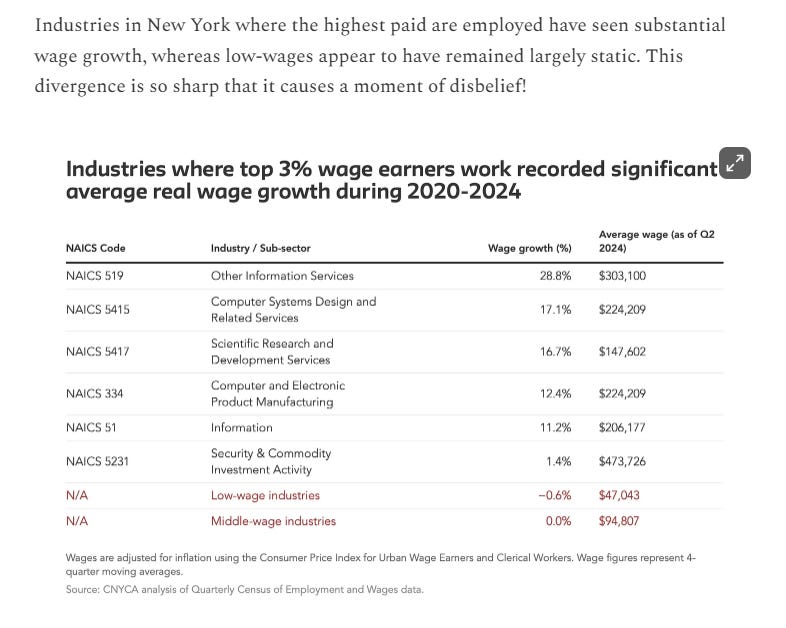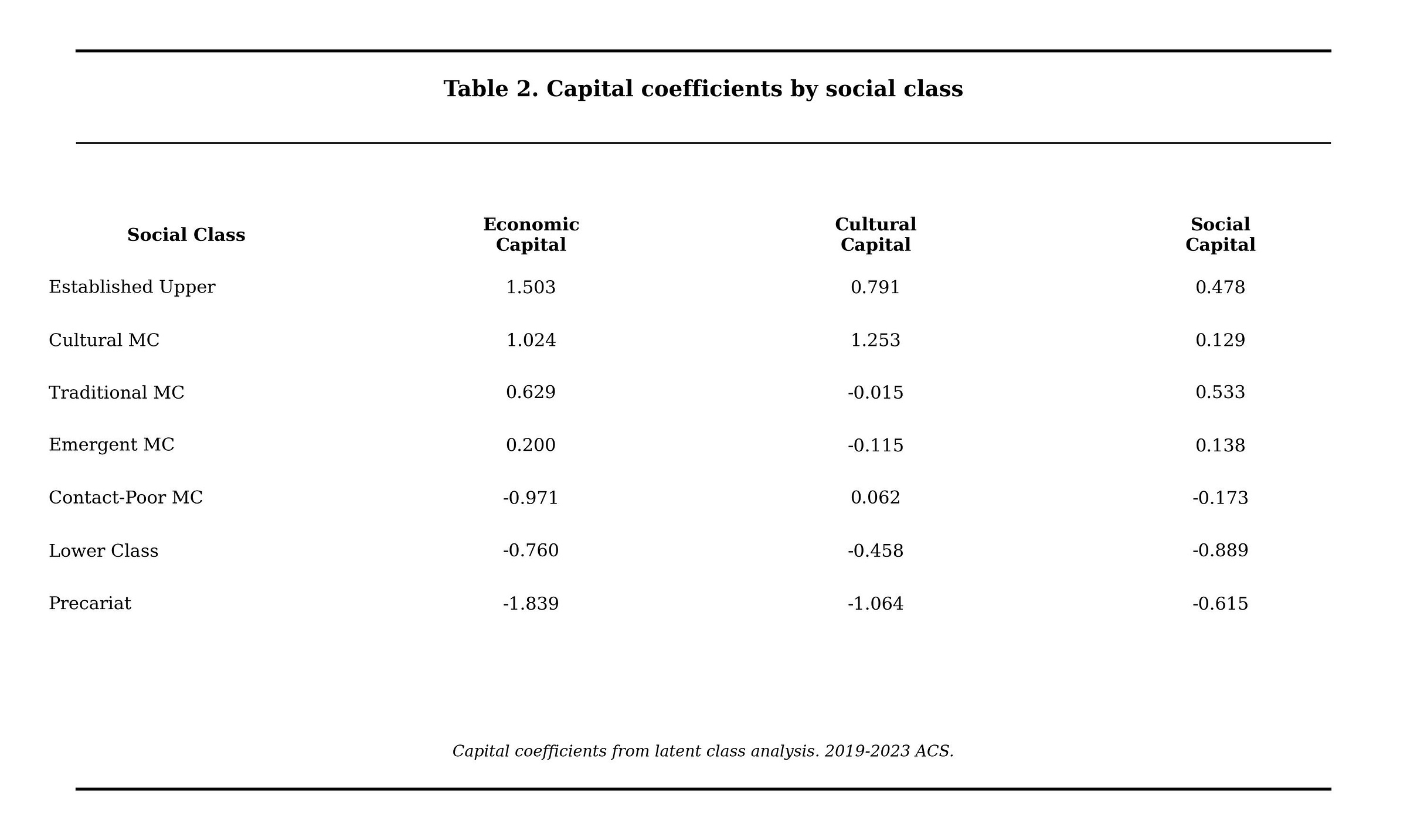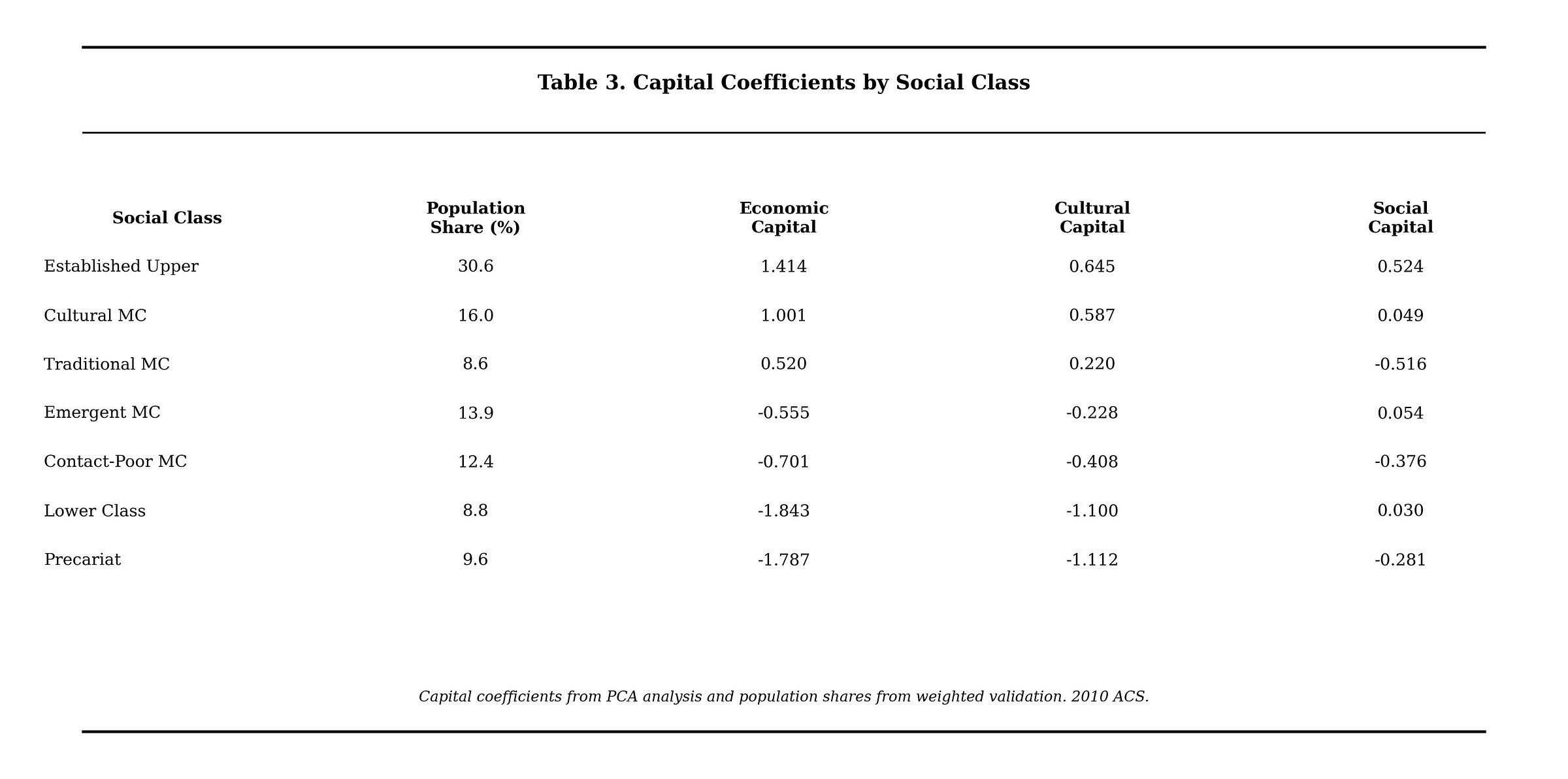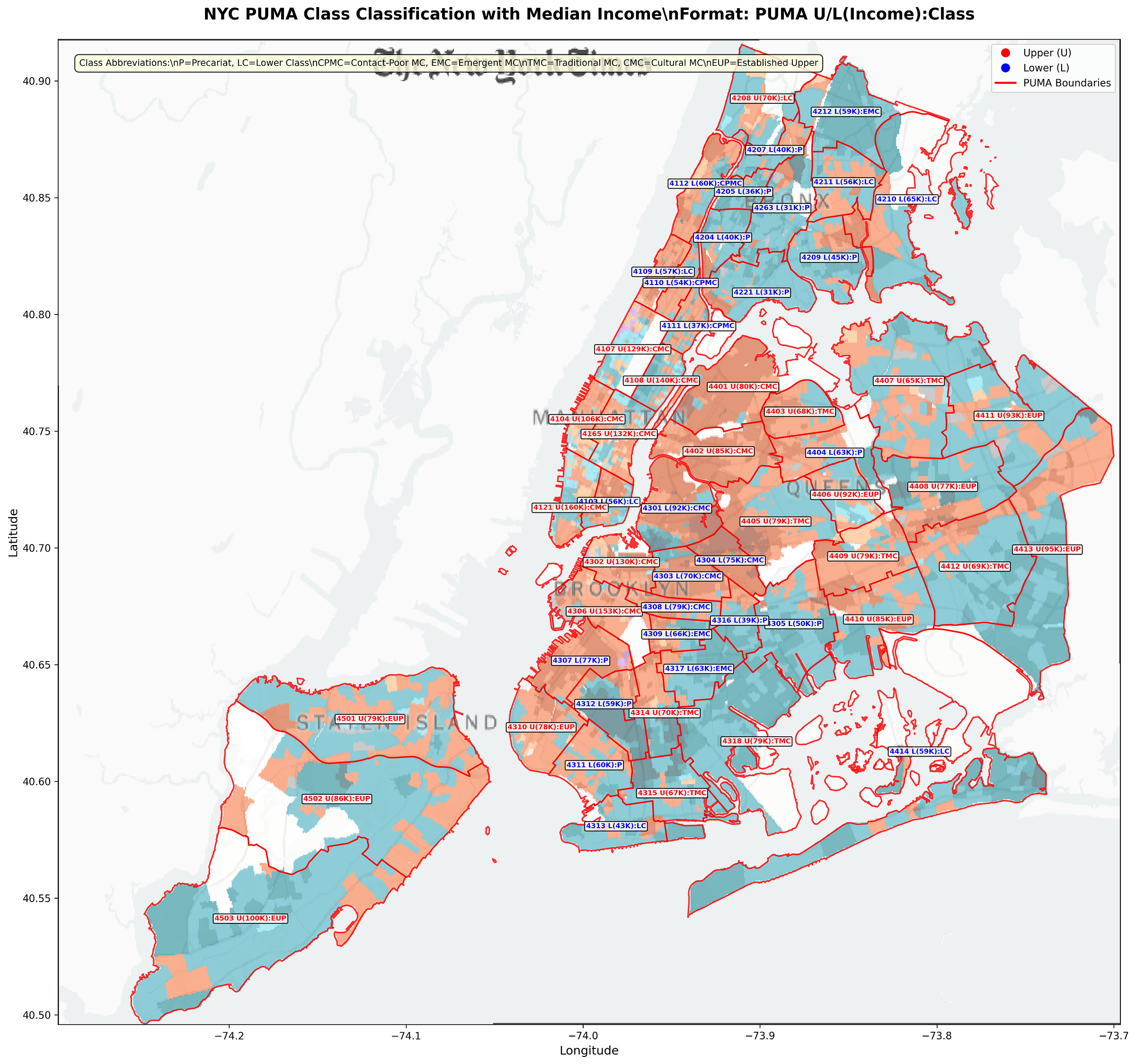The Rabble: From the French Revolution to the Turbulent Twenties
An o3 Assisted Data Exercise of Class Dynamics in NYC Mayoral Race
“The Dao gives birth to the One (the nation). The One gives birth to the Two (capital & labor). The Two give birth to the Three (upper, middle, lower class). The Three give birth to the ten thousand things (social whole as it actually is engendering infinite regress),” Laozi (with parenthetical notes).
“To generalize is to be an idiot. To particularize is the alone distinction of merit,” the Romantic painter, William Blake.
“Large questions about the nature of change have tended to belong more to philosophers than historians….The growing accessibility of quantitative evidence allows us to convert a metaphysical conundrum into an empirical question….Samuel Johnson: ‘That, sir, is the good of counting. It brings everything to a certainty, which before floated in the mind indefinitely,” David Hackett Fisher in The Great Wave.
I hesitate to present the data in the detail I have already unpacked in my file directories. I was provoked by a very interesting Toozebook, ostensibly interpreting the stunning Mamdani upset in the New York mayoral race, but hardly underneath the surface a commentary on the extreme hourglass trajectory of the broader American economy over the last 20 years or so. Conservatives who have benefitted should have anticipated the Polanyian repercussions.
I return to the word “hesitate”, as I do not want to go too far down the Polanyian frame. American politics is increasingly determined by who does well in TikTokesque shortform video. If you truly want to understand why candidates succeed and fail you are thinking too hard if you specify a sophisticated model enriched with the whole suite of class and ideology variables. I imagine a mantra for political horseraces in similar vein as AI/ML studies, Attention is All You Need. What makes this moment so interesting is the mantra is more than a metaphor; you are not thinking creatively enough if you do not imagine the background processes of modernity battling—“ignorant armies clashing by night”— over the future of the battered demos.
Too often, I think dedicated researchers with impossibly wide interests do not quite understand the full powers of the tools at their disposal to answer all the what if questions which enter any person’s head as they engage in research: “Oh look, I have just stumbled on this fascinating Bordieuan inspired class analysis of Rotterdam. I have just ran three searches to inspect if anything similar exists for NYC. It appears not—time to move onto my stack which, in the age of instant connection to anybody and everything that has ever existed, veloziferischally grows beyond my ability to reasonably manage.”
The opportunity for Enlightenment has been missed if we do not take the moment to deploy the alien beings which live inside our laptops. “Hey o3 (a PhD assistant any faculty member would be delighted to stumble upon) I find this paper “The urban class structure: class change and spatial divisions from a multidimensional class perspective” (2021) by two Dutch researchers fascinating, I want to adapt it for a major American city, say New York City. It does not need to be a complete population survey, rely on whatever Census proxies which are easily accessible and apply population weights to whip up some analysis to help me better understand social reality that I navigate every day. I have no illusions that this work will ever be published. I am simply curious. I want to understand the dimensions and transformations of class in American today, grounding as much as possible in data while understanding we are transforming the “dog” of reality into a “cat” (eg Erica Thompson Escape from Model Land). The cat is nonsense, but I have found, even with my pair of young eyes, that nonsense, arbitrary distortions which allow us to proceed, is often useful. Let’s proceed.”
Needless to say, that is not a word-for-word retrieval of my prompt to o3, but is included to provoke. Dare to know! Dare to lose control! The second chant comes to mind after finishing an enlighteningly dated yet prophetic book, Out of Control. I imagine the 10,000 fellow travelers who also own a copy who treat it as a pseudo-religious text. That we cannot expect to dictate the alien beings we have imagined for decades only now beginning to produce and the butterfly effects they engender, and it would not be desirable if we could. A fully rationalized world, where everything is so algorithmically governed that imagination is conflated with mental disorder1, is a dead world.
LLM’s have not been used well. The discourse reminds us they are currently tearing apart all levels of education. But the algorithm that is the basis of all neural nets is also suited to reviving imagination, to do nothing less than contemplate social realities that would otherwise be totally beyond (for non-domain experts) or at the edge of (for domain experts) comprehension.
The dialectic irony—in Jamesonian fashion—is hard to miss. It might be the algorithm is sapping our collective imagination, contributing to “the slow cancellation of the future”. Just as accurately, if we renew in quest to be aware of the background technologies, these ambiguous encounters can kindle a revolutionary ethic—the late Mark Fisher called it “consciousness raising”. I can imagine the young Marx brought to San Dimas in 2025 busying himself in his preferred AI terminal setup to get in a crash course in data science suited for his own open-ended wanderings to contemplate the social whole. Math and poetry. That which is always denied by the obscuring powers, which is all the more reason that it ought to be the subject of thought.
NYC Mayoral Race: A Coalition of the Disenchanted Rabble?
New York City is a place which, largely due its outsized role in TV and film, captures the imagination more than it is representative of any real place. In American politics, in particular, it is worth noting that by the international standard—a dense place with accessible public goods— NYC is the only US metro which qualifies as a city. Other factors, as I noted in my 2023 reflection on UCLA’s Nationscape survey, make it sui generis. The most educated region in the world is the 5-mile half-radius from lower Manhattan. It’s also among the top-10 most racially segregated US metros. Equally salient, I noted in my earlier piece, residents are extremely socially conservative compared to their cousin districts in Silicon Valley and Seattle. Though, perhaps foreshadowing the result this year, they are not out of step on the economic axis.
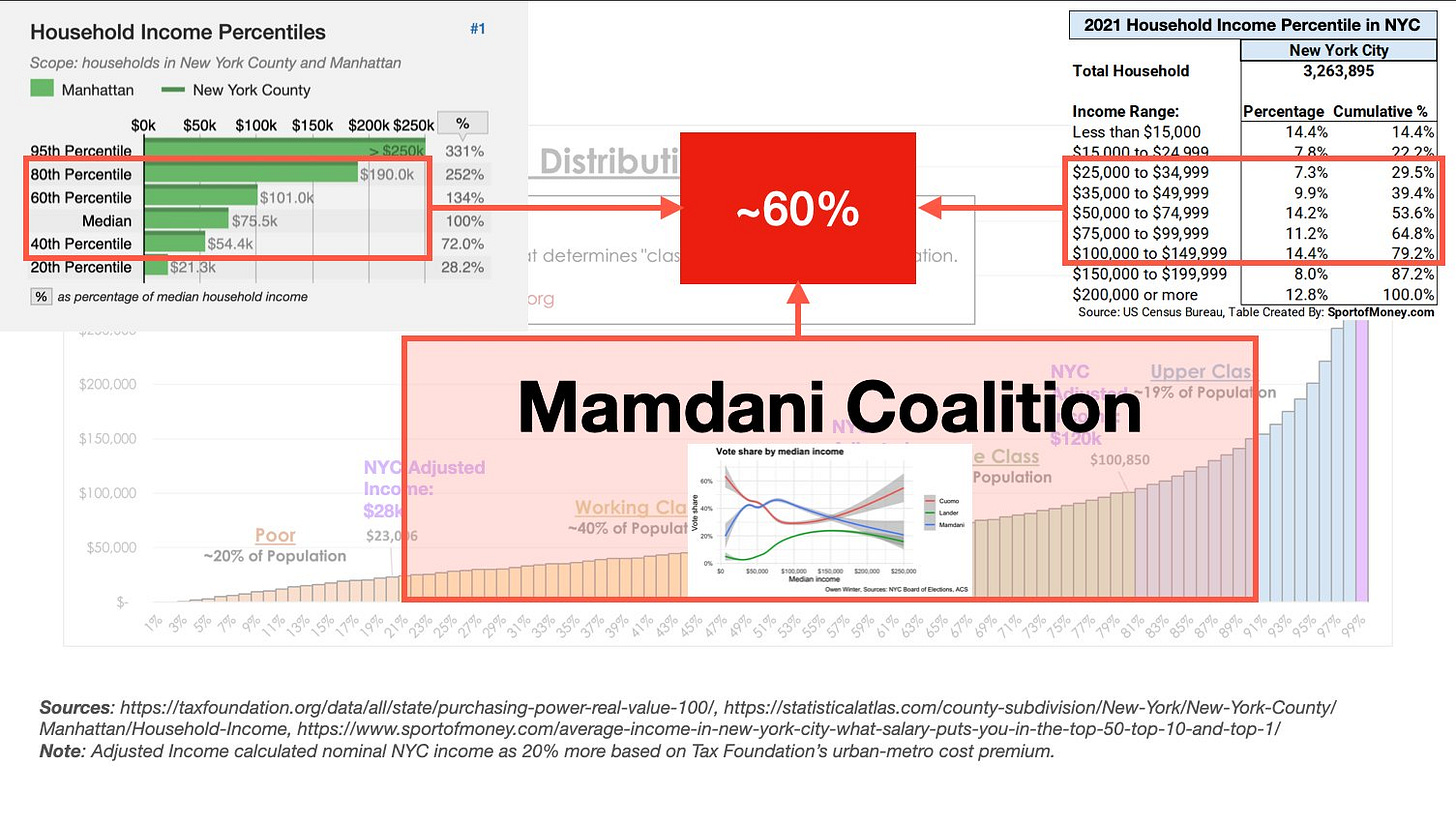
Holding all these caveats aside, when I ponder this eye-popping result from my perch three-thousand miles away in sunny California, I cannot help but wonder the explosive synthesis of education and affordability will deluge American politics at the national level.
Historically, as Mann has written in a book which is one answer to the “too soon to tell” riddle of the French Revolution, the rabble, or in Hegel’s original German, Pobels, is not so much a class associated with a strict definition of income level indexed to a given basket of goods but the subjective response as a result of social disintermediation. Tell me, reading Mann, does your mind not drift to how, as self-identified bourgeois Man grows increasingly disenchanted no longer carrying the phrónēsis of experiential knowledge, he becomes prone to the rabble’s instincts?
The rabble are ‘naturally’ rabble. No individual ‘chooses’…he or she is driven there…in which productivity ‘increases in an unending large proportion to consumer need, and thus in the end even those who work hard cannot earn their bread’…to be rabble opposite of free….alienated…'left with the needs of civil society and yet —since society has the same time taken from the means of natural acquisition, and also dissolves the bond of the family in its wider sense as the kinship group—they are more or less deprived of all the advantages of society’…a ‘large mass of people sinks below the level of certain standard of living’ and ‘that feeling of right, integrity, and honour which comes from supporting oneself by one’s own activity and work is lost. This leads to the creation of a rabble, which in turn makes it easier for disproportionate wealth to be concentrated in a few hands (emphasis mine)’…the problem is not poverty per se, but rather the ‘disposition associated with poverty, inward rebellion against the rich, against society, the government, etc (‘Geoff Mann, In the Long Run We’re All Dead)
There is a conflict here between the demands of close textual analysis, referring explicitly to the poor in a context where they comprised ~80 percent, a typical power law, and the stretched interpretation adapted to contemporary social realities. But I like the elegance of the Weber-Hegel rabble-as-disenchantment syncretic theory to explain the current lay of the land. The bottom of the class hierarchy does not engage with any of the background technologies of modernity, and therefore unburdened by not knowing what they do not know. When they rebel, it is outside of formal politics.
The middle, as Hegel wrote above, has no choice but to engage “productivity ‘increases in unending large proportion to consumer need”. The lack of decision, stuck in mere “choice”, presents a problem. As Knausgård wrote in a brilliant essay for the 175th edition of Harper’s, you are a very unusual person if you have even dim awareness of the digital bits which dictate the structure of everyday life. He is also right to suspect that more people in this segment are following his quest to Enlightenment, The Reenchanted World, liminal encounters with depressed theorists of modernity, who compose titles like The New Dark Age.
Then, as Tooze highlighted with an astonishing table, there is a third group. They are rarely enchanted, but they are emphatically burdened with structuring modernity, often because they are following rigid rationalities at the expense of all else to the detriment of those in the middle. My favorite example is what is currently source of much consternation among software nerds I know, how much adware is filled in today’s operating systems. What utopia we could build with today’s hardware if miserable software developers were not explicitly instructed to build design architectures which leave profits before people! These cybernetic dysfunctions notwithstanding, ie the purpose of a system is what it does, the upshot to belonging to this top 3% segment, is you are handsomely compensated. Note the NAICS codes are exclusively in industries which build the structure of reality; as Matt Levine once proclaimed, “all modern life consists of entries into databases.” One doubts as hyperbole until you begin to delve deeper into the “heart of the heart”.
Liminal Encounters with Sonnet/O3 Shoggoth toward “Heart of Heart” of Class
I mentioned earlier that I used the Rotterdam paper will serve as the basis of the class analysis presented in this wandering blog post. I am in broad agreement with the authors with the sevenfold division of the class hierarchy: established upper, cultural middle class (MC), traditional MC, emerging MC, contact-poor MC, lower class, and precariat. It overcomes the crude reductions of upper-middle-lower scheme, allowing for instance possibilities of middle-income high-culture brahmin caste, exerting its influence in the realm of ideas. Simultaneously, it prevents us from falling into the problem of infinite regress, staring at the “tens of thousands of things” mentioned in the hook. That is always the danger in our world of ubiquitous data access.
The authors did consider a ninefold division, which is potentially interesting, as it would likely reveal a category which is obscured at lower dimension, the cultural precariat. People with extremely high levels of education but low incomes. It’s likely a vanishingly small group, but not totally escaping detection—large enough perhaps to explain odd inconsistencies in Atlanta Fed’s wage tracker by income and education quartiles.
To be perfectly honest, I let o3-Sonnett do most of the heavy lifting for developing the methodology. The important thing to note is in the original paper standard measures of income and wealth comprise economic capital, to be sure important in class analysis but not to the exclusion of all else. Cultural capital is principally educational attainment with some other factors added on. Social capital is the most indirect, a mishmash of proxy variables which might carry some signal to social capital. In spite of the imprecision of the data collection, I was astonished by how the latent class analysis aligned with intuitions on the shifting involvements of class in America:
Established upper are the top of the social pyramid, who in spite of their position are eclipsed by a significantly smaller group of hyper-credentialed knowledge workers. The largest group, the traditional middle class, doesn’t do as well as either along either axis, but still does pretty well owing to its deep reserves of social capital. The emergent middle class is a euphemism; it’s the class that imitates the traditional middle class, but with less success. The contact-poor middle class is similar to the “cultural precariat” category that I speculated about above. They perform much less well in labor markets than their endowment of education would suggest, because they don’t have the social contacts to exploit the knowledge they’ve obtained. We’ll see that a major difference between the Bronx and Harlem is Harlem is where the contact-poor middle class lives. Unlike the precariat, their occupational statuses resemble the traditional middle class cousins, just in the pauperized versions of each profession. Lower class and the precariat are similar except they are on opposite poles of the recent immigrant status distribution. Because the precariat is the mostly likely to be recent immigrants, they also are more likely to have a small cushion of social capital, a perennial survival strategy of immigrants looking to make their way in the unforgiving American social landscape.
We can present the same data a little more precisely by looking at the descriptive statistics. Predicably, home ownership rates are highest for established upper followed by the traditional middle class. The cultural middle class laps everybody on over 25 bachelor degree share. Notably, the contact-poor middle class is more likely to have a degree than the traditional middle class. Perhaps the sharpest division between the established upper and the traditional middle class with those on the other side of the social hierarchy, emergent and contact-poor middle classes is they have much more traditional household types. There is a voluminous literature on the negative effects of divorce on the longitudinal outcomes of children which upper reaches of the class hierarchy know without studying. As noted above, the precariat has many disadvantages, notably abysmal education levels and very high disability shares, but household formation is interestingly not among them.
So far so good with the o3 assisted data analysis. As a quick sanity check, “show me the professional categories of each class assignment”:

Something immediately pops off in this table. The “Management” (MGR) in Professional Managerial Class (PMC) appears as the top classification for both the established upper and the cultural middle class. The legitimation mandarins (EDU), the 20 percent or so Chomsky identified as crucial in manufacturing consent, also appear in these two rungs. Management appears as secondary to office (OFF) for both the traditional middle class and the emerging middle class. The backbone of the care economy, healthcare and support (HLS), is the contact-poor middle class. The lower class has similar high-level designations as the cultural middle class, but if you dig deeper into more granular assignments, you will quickly learn that “entertainment” and “management” labels do not represent the same status signal. As expected, labels change more dramatically with the precariat, with food service (EAT) appearing on the list (though notably not construction).
It’s worth copying the granular manager list both to demonstrate the stratification within occupational categories and to clarify the essence of the pressure which has been introduced to upper segments as tiny substratum within the bold categories gravitationally pushes the rest:
MGR-Chief Executives And Legislators MGR-General And Operations Managers MGR-Advertising And Promotions Managers MGR-Marketing Managers MGR-Sales Managers MGR-Public Relations And Fundraising Managers MGR-Administrative Services Managers MGR-Facilities Managers MGR-Computer And Information Systems Managers MGR-Financial Managers MGR-Compensation And Benefits Managers MGR-Human Resources Managers MGR-Training And Development Managers MGR-Industrial Production Managers MGR-Purchasing Managers MGR-Transportation, Storage, And Distribution Managers MGR-Farmers, Ranchers, And Other Agricultural Managers MGR-Construction Managers MGR-Education And Childcare Administrators MGR-Architectural And Engineering Managers MGR-Food Service Managers MGR-Entertainment And Recreation Managers MGR-Lodging Managers MGR-Medical And Health Services Managers MGR-Natural Sciences Managers MGR-Property, Real Estate, And Community Association Managers MGR-Social And Community Service Managers MGR-Emergency Management Directors
Fear of Falling in New York City: How does Class Nexus compare to the Aughts?
A natural question emerges which turns out to be much more difficult to have o3 one-shot than I expected due to inconsistencies in the relevant census designation over time. How does the class nexus compare with the recent past? Has something changed after the Great Recession which has heightened class anxieties? It turns out that after I engaged in a little too much manual work to clean out the inconsistencies the answer is yes, using 2006-2010 ACS series. Recall the clustering of the PCA analysis is not fixed. This is undesirable if we want strict category assignments i.e. traditional middle class is economically medium-high, educationally medium-low, and socially high with most conventional household formations. But it is desirable to the extent that class is viewed as a living entity. You do not need to retreat that far in time to get an altogether different split:
At the risk of reading too much into this table, the most salient observation is the modal class with highest social capital is not the traditional middle class as was true in current ACS series, but established upper. The transformation of the class pyramid is that about one-third has moved two rungs down to the traditional middle class, and about one-half out of the cultural middle class. This sorting has contributed to the prestige of upper two managerial classes, as the price of entry into either class with wealth or education has increased significantly. Psychically for downwardly mobile members of traditional middle class, with zero inflation-adjusted wage growth in recent years, is the anxiety their managerial status is being diluted because they are not constantly advancing. In the Red Queen world, chiefly informatics, that simply means you will be replaced by those who do rationality better. A random Youtube video in the informatics space captures the anxieties of the “Cindys” (a hypothetical HR exec, a non-bold MGR occupation) of being replaced (and the business opportunity it presents to profit off anxiety).
Recall the difference between the two top classes with the traditional middle class, the first two classes do management primarily and don’t do enough administrative work to register in my scripting, while the middle class does administrative work primarily. The thunder of class ecologies does not so much have to do with the gradual procession of abiotic shock adjustments (tech) but, more precisely, biotic threats from competitors within the stratum (ICT managers), and the resentment it engenders on the part of the losing members of the better half.
Too Soon to Tell: Toward an Organized Rabble Movement
On the erosion of ethical substance, Sittlichkeit, “According to the principle of atomicity, each cares merely for himself, and does not concern himself about anything in common…This principle gives such a person over to contingency. Our standpoint of reflection, this spirit of atomicity, this spirit of finding your honour in your individuality and not in what is common – this is destructive,” Hegel.
Let’s return to the Mamdani/Cuomo horse race. We can see very quickly that Cuomo did very well at opposite poles of the income distribution, whether in the Bronx, the orthodox Jewish communities in Brooklyn, or the Upper West/East side. And secondarily, assuming the first principle does not take priority, Mamdani did extraordinarily well in any community where the cultural middle class or contact-poor middle class is overrepresented. All other things being equal, density also seems to play a factor with a Mamdani line running West toward Nassau County. The chart first indicates the Public-Use Microdata Area (PUMA), then whether the residents skew toward upper (U) or lower (L) half of the class distribution, followed by median income in parentheses and most-overrepresented class abbreviation.
Chart 1. New York Times NYC Mayoral Precinct Map overlayed with PUMA & Class Identifiers
The prior speculation that the traditional middle class is facing the greatest status anxieties and might exhibit the most acute stress response by voting Mamdani does not fit the data. The traditional middle classes if they are not intermixed with cultural middle class influence— i.e. the typical Staten Island precinct— are strong Cuomo voters. We produce a chart which shades by color depending on which class(s) are overrepresented. Flag is assigned if 1.5x for primary class (square in key) or 2x if secondary class (circle). Alternating color bands represent both corresponding classes are overrepresented in that PUMA. The strongest Mamdani support is in lower class areas overall where the cultural middle class is overrepresented as a significant minority (4301, 4304, 4307). For politics to truly deluge, education is the key ingredient. Faltering status expectations and stagnant incomes are not sufficient.
Chart 2. Census PUMAs with Given Class Over-Representation
The Ghosts of Our Future
The speculation of how the traditional middle class responds to its mounting anxieties is not currently an active matter of concern. To the chagrin of the Left, they are firmly out of step with the Zohran-Bernie-AOC priority list. Yet, I think any signal I receive here, whether retrieved through a simple search query or an AI-augmented exploration suggests they are rapidly being transformed into rabble. Perhaps only incipiently. Plenty of honor is retained in the industries which the giant vampire squid does not yet bother to wrap itself around. The intermediacy of the phase transition emphasizes the opportunity of the moment. Like the prior Byronic role, for the educated to fill their historic mission to raise consciousness of what is being done to us. To execute the double movement.
The strongest data point of what could be coming for American politics was ultimately what tipped the balance for Mamdani in this primary election, youth turnout, disproportionately college educated. If that giant is summoned from its slumber, there is little doubt it will shake the world. In the process, we may still make the process needed on the “frightful muddle, a transitory and unnecessary one” to reorient political economy:
“The state must also be both anticipatory and pharmaceutical, that is, it must constantly monitor the present with its relation to the future in mind and be ready to diagnose problems and administer solutions to meet immediate necessity. And it must do so in the knowledge uncertainty troubles both such efforts….Modern government thus requires a science of these relations —of the present to the future, and of diagnosis to prescription: political economy. The state is the only institution that can ensure … ‘sufficient honour’ and political economy is the means to that end.” (Mann, In the Long Run).
The setting of a lesser known dystopian novel, which is nonetheless perhaps a more precise diagnosis of contemporary moment than the other two novels which captured mid-Century imagination, Skidelsky writes in Mindless.





